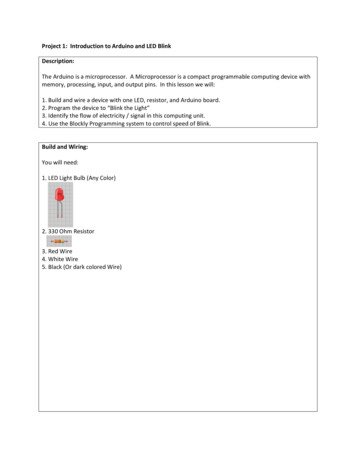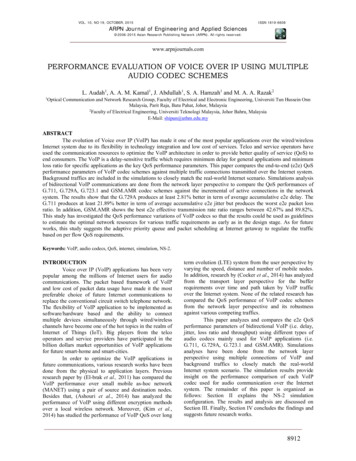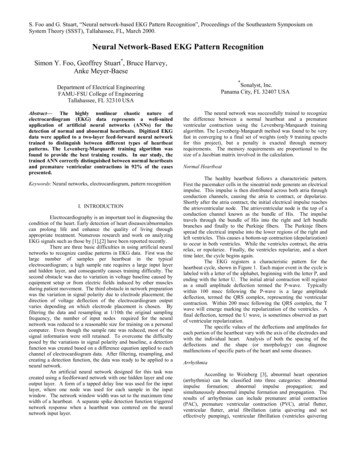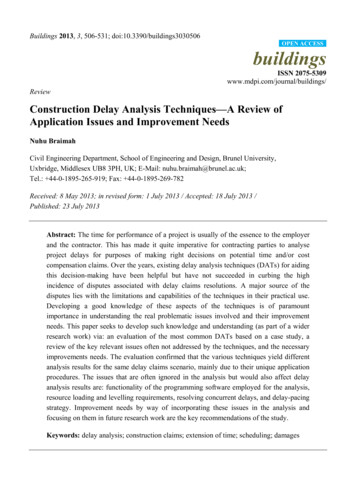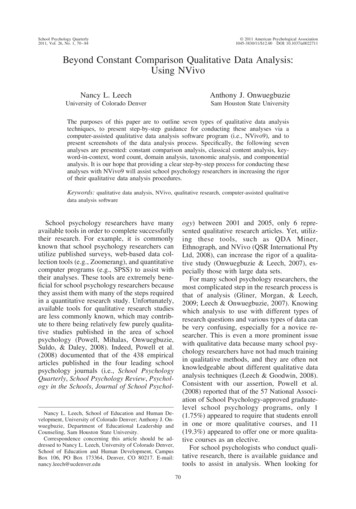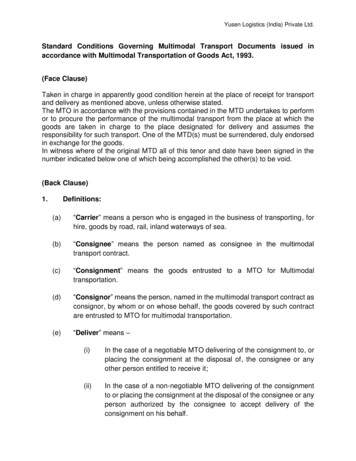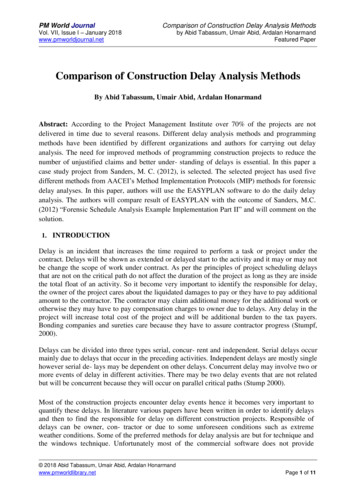
Transcription
PM World JournalComparison of Construction Delay Analysis MethodsVol. VII, Issue I – January 2018www.pmworldjournal.netby Abid Tabassum, Umair Abid, Ardalan HonarmandFeatured PaperComparison of Construction Delay Analysis MethodsBy Abid Tabassum, Umair Abid, Ardalan HonarmandAbstract: According to the Project Management Institute over 70% of the projects are notdelivered in time due to several reasons. Different delay analysis methods and programmingmethods have been identified by different organizations and authors for carrying out delayanalysis. The need for improved methods of programming construction projects to reduce thenumber of unjustified claims and better under- standing of delays is essential. In this paper acase study project from Sanders, M. C. (2012), is selected. The selected project has used fivedifferent methods from AACEI’s Method Implementation Protocols (MIP) methods for forensicdelay analyses. In this paper, authors will use the EASYPLAN software to do the daily delayanalysis. The authors will compare result of EASYPLAN with the outcome of Sanders, M.C.(2012) “Forensic Schedule Analysis Example Implementation Part II” and will comment on thesolution.1. INTRODUCTIONDelay is an incident that increases the time required to perform a task or project under thecontract. Delays will be shown as extended or delayed start to the activity and it may or may notbe change the scope of work under contract. As per the principles of project scheduling delaysthat are not on the critical path do not affect the duration of the project as long as they are insidethe total float of an activity. So it become very important to identify the responsible for delay,the owner of the project cares about the liquidated damages to pay or they have to pay additionalamount to the contractor. The contractor may claim additional money for the additional work orotherwise they may have to pay compensation charges to owner due to delays. Any delay in theproject will increase total cost of the project and will be additional burden to the tax payers.Bonding companies and sureties care because they have to assure contractor progress (Stumpf,2000).Delays can be divided into three types serial, concur- rent and independent. Serial delays occurmainly due to delays that occur in the preceding activities. Independent delays are mostly singlehowever serial de- lays may be dependent on other delays. Concurrent delay may involve two ormore events of delay in different activities. There may be two delay events that are not relatedbut will be concurrent because they will occur on parallel critical paths (Stump 2000).Most of the construction projects encounter delay events hence it becomes very important toquantify these delays. In literature various papers have been written in order to identify delaysand then to find the responsible for delay on different construction projects. Responsible ofdelays can be owner, con- tractor or due to some unforeseen conditions such as extremeweather conditions. Some of the preferred methods for delay analysis are but for technique andthe windows technique. Unfortunately most of the commercial software does not provide 2018 Abid Tabassum, Umair Abid, Ardalan Honarmandwww.pmworldlibrary.netPage 1 of 11
PM World JournalComparison of Construction Delay Analysis MethodsVol. VII, Issue I – January 2018www.pmworldjournal.netby Abid Tabassum, Umair Abid, Ardalan HonarmandFeatured Paperrepresentation for delays. A delay event is normally represented by dividing the activity intoparts to introduce delays on commercial software. Hence it becomes a tough manual task toperform delay analysis using such commercial software (Hegazy 2005).In this report section 2 deals with Forensic schedule Analysis. Section 3 consists of descriptionof Easy Plan software and its features. Section 4 deals with methodology and results. Section 5and 6 consist of conclusion and references.2. FORENSIC SCHEDULE ANALYSISDaily Delay Analysis Method (DDM)In order to improve the limitations of window analysis, Hegazy & Zhang (2005) introducedchanges to window analysis method. He proposed a daily windows method for allocatingconcurrent delays and accelerations. This method uses a window size of one day to account forall fluctuations that occur in the project’s critical paths. It is considered as an important andaccurate method. “It takes into consideration the effects of baseline updates, resource allocationand the effects of actions taken by the contractor to accelerate the project and minimizepotential de- lays as it usually ignored in delay analysis” (Yang & Kao, 2009).The best approach to consider all variations in critical path is to use small window size. Withthis analysis some of the steps can be refined to produce more practical results like when weintroduce changes to the logical relationships among activities (Hegazy & Zhang, 2005).According to Hegazy & Zhang (2005), the daily window analysis has a practical value forindustry practitioners and researchers. For industry practitioners it represents an organizedprocedure for evaluating delay responsibility and recording site progress. For researchers itembodies significant step toward developing dynamic progress control, resolving conflicts onprojects and primary corrective actionsBenefits of Daily Delay Analysis are the following: (Hegazy & Zhang, 2005; Hegazy & Menesi,2008) It is a flexible approachIt has a potential of improvementsAfter entering the data some of the steps can be refinedIt clearly show progress information and any delaysIt has a great ability to provide accurate and tra- ceable results.MIP 3.1 Observational/Static/Gross AnalysisObservational/Static/Gross analysis is performed based on the Method Implementation Protocols3.1 (MIP 3.1). In this method, the as-planned schedule is compared to the as-built schedulewhich is shown in Figure 1. The critical path in the as-planned schedule is used as to identify thedelays. It can be seen that there are no additive or subtractive events from the schedule. Thus,the delays are analyzed by com- paring the as planned and as built schedules after it occurs. Itshould be noticed that the interim updates are not analyzed. This is because they only reflect asubset of the information that is ultimately captured in the final as built schedule. Besides, MIP3.1 re- commends the following implementation of the Source Validation Protocols (SVPs): 1. 2018 Abid Tabassum, Umair Abid, Ardalan Honarmandwww.pmworldlibrary.netPage 2 of 11
PM World JournalComparison of Construction Delay Analysis MethodsVol. VII, Issue I – January 2018www.pmworldjournal.netby Abid Tabassum, Umair Abid, Ardalan HonarmandFeatured PaperSVP 2.1 (baseline validation), 2. SVP 2.2 (as-built validation), 3. SVP 2.3 (update validation)and 4. SVP 2.4 (delay ID & quantification).Fig. 1. MIP 3.1 Observational/Static/Gross Analysis (AACEI)MIP 3.2 Observational/Static/Periodic AnalysisObservational /Static/Periodic analysis is performed based on the Method ImplementationProtocols 3.2 (MIP 3.2). Similar to MIP 3.1, the as-planned schedule is compared to the asbuilt schedule in MIP 3.2 as shown in Figure 2. From this figure, it can be seen that thedifference in MIP 3.2 as compared to MIP 3.1 is: the analysis is performed with multiplesegments of the project instead of one whole continuum. In other words, MIP 3.2 is theenhanced method of MIP 3.1. Thus the method of MIP 3.2 is usually implemented after MIP3.1. Same as in MIP 3.1, the critical path in the as-planned schedule is used as to identify thedelays. As there are no additive or subtractive events from the schedule, the de- lays areanalyzed by comparing the as planned and as-built schedules after it occurs. In addition, because the schedule is updated by the end of each period, thus the delays are analyzed bycomparing the as planned and as built schedules in different periods. In MIP 3.2, sameimplementation of SVPs is recommended as in MIP 3.1. 2018 Abid Tabassum, Umair Abid, Ardalan Honarmandwww.pmworldlibrary.netPage 3 of 11
PM World JournalComparison of Construction Delay Analysis MethodsVol. VII, Issue I – January 2018www.pmworldjournal.netby Abid Tabassum, Umair Abid, Ardalan HonarmandFeatured PaperFig. 2. Graphic illustration of MIP 3.2 Observational/Static/Periodic Analysis (AACEI)MIP 3.8 Modeled/Subtractive/Single SimulationModeled/Subtractive/Single Simulation is performed based on the Method ImplementationProtocols 3.8 (MIP 3.8). In this method, a critical path method (CPM) model is selected first.Then, a scenario simulation is carried out based on this model. As shown in Figure 3, theanalysis is performed after the delay occurs. The delay events are modeled in the as-builtschedule. Thus, the delays are analyzed by removing delay events from as built schedule. Inother words, it is a single simulation. Due to this, this method is a static logic one. It should benoticed that there is no progressive updates in the as-built schedule. That means, it is notforensically accurate. Besides, MIP 3.8 recommends the following implementation of theSVPs: 1. SVP 2.2 (as-built validation) and 2. SVP 2.4 (delay ID and quantification); as well asthe enhanced SVPs of: 1. SVP 2.1 (base- line validation) and 2. SVP 2.3 (update validation).3. EASY PLANEasy Plan (Hegazy 2007) is a software for scheduling, estimating, resource management,project control and delay analysis which is developed by using the VBA language of MicrosoftExcel (Jafar, 2011).Fig. 3. Graphic illustration of MIP 3.8 Modeled/Subtractive/Single Simulation (AACEI)Key features of EASYPLAN: (Jafar, 2011; Yang & Kao, 2009) It allows the user to specify up to 3 estimates for each activity and to enter up to three keyre- sources and to specify the daily limit of these resourcesIt informs the user if the resource limits are exceeded and allows the user to change themethod of execution of any activity.It permits more than one baseline to be saved. 2018 Abid Tabassum, Umair Abid, Ardalan Honarmandwww.pmworldlibrary.netPage 4 of 11
PM World JournalComparison of Construction Delay Analysis MethodsVol. VII, Issue I – January 2018www.pmworldjournal.net by Abid Tabassum, Umair Abid, Ardalan HonarmandFeatured PaperDaily progress of activities is entered as a percentage or as delay by each party.It allows the user to specify the project deadline and notifies the user if the projectduration exceeds the deadline.It has two bars for activities: The top bar represents the baseline, and the bottom representsthe progress.It takes into consideration all the delays, accelerations, and slowdowns.Fig. 4. As-planned schedule4. METHODOLOGY AND RESULTSMethodologyThe flow chart that shows the EASYPLAN procedure for performing daily delay analysis isdepicted in fig. 5. 2018 Abid Tabassum, Umair Abid, Ardalan Honarmandwww.pmworldlibrary.netPage 5 of 11
PM World JournalComparison of Construction Delay Analysis MethodsVol. VII, Issue I – January 2018www.pmworldjournal.netby Abid Tabassum, Umair Abid, Ardalan HonarmandFeatured PaperFig. 5. Flow Chart for EASYPLAN Procedure (Jafar, 2011).The following methodology was used to input data into EASYPLAN:1. The data for the project (Sanders, 2012) was converted into the author's pre-defined2.3.4.5.6.7.manner for input into EASYPLAN.Data including activity name, start date and ac- tivities duration were entered into MSProject and then imported to EASYPLAN.Schedule of project was prepared as depicted in fig. 4.This schedule was saved as a “baseline” for the project shown in fig. 6.All the progress was entered on a daily basis, using EASYPLAN "Enter dailyprogress" fea- ture.An As-built schedule of the project after enter- ing all the events, in which the projectfinished on Day 24 with all the delays incorporated, was developed.After entering the as-built progress, “Windows analysis’’ was selected to show asummary of delay analysis. (fig. 7)ResultsEASYPLAN is user friendly software that provides a number of results for a given set of datafor better understanding and analysis. For the daily delay analysis, EASYPLAN produced thefollowing: A detailed schedule depicting as-planned vs. as- built (as shown in figure 8)Summary of the results as shown in figure 7.A text file that shows detailed analysis of the whole project on daily basis (including 2018 Abid Tabassum, Umair Abid, Ardalan Honarmandwww.pmworldlibrary.netPage 6 of 11
PM World JournalComparison of Construction Delay Analysis MethodsVol. VII, Issue I – January 2018www.pmworldjournal.netby Abid Tabassum, Umair Abid, Ardalan HonarmandFeatured Paperowner and contractor delays as well owner directed or contractor's self-acceleration) andthe reason for the delay. A sample of the text file is shown in table 1.As depicted in figure 7, the results indicate that the contractor was responsible for seven daysdelay; owner was responsible for 3 days delays. There was acceleration of two days by thecontractor.Project As-Built Duration (days) 24.0Project Baseline Duration (days) 16.0Day: 1 (Tuesday, Jan 10 2012), Previous Duration 16.0Progress data of Day 1 is now entered. The result is:Current Duration 17.0Activity 1-S100 (Excavation) has a O-delay because of Contractoruncovered Underground Storage Tank (UST) on Thursday of week 1and asked for RFICompensable Owner delays (O) 1.00, Owner Acceleration 0.00.Contractor delays(C) 0.00, Contractor Acceleration 0.00.Excusable delays(N) 0.00.Table 1. Portion of EASYPLAN output for delay cceleration000000001000000001000000Net Delay-1-1-1000001-1-100-1-1-101-10-1000-8Total delay for the projectTable 2. Detailed daily delay analysis for projectThe daily delay analysis for the project carried out using EASYPLAN is provided in table 2.The comparative results for different forensic analysis method including Daily Delay Method(DDM) are shown in table ationNetDelayDDM37-28 2018 Abid Tabassum, Umair Abid, Ardalan Honarmandwww.pmworldlibrary.netPage 7 of 11
PM World JournalComparison of Construction Delay Analysis MethodsVol. VII, Issue I – January 2018www.pmworldjournal.netby Abid Tabassum, Umair Abid, Ardalan HonarmandFeatured PaperMIP 3.138-38MIP 3.238-38MIP 3.33508MIP 3.73508MIP 3.838-38Table 3: Delay comparison for different methodsThe MIPs have the same result for Owner's delay; however different methods differ in resultsof Con- tractor delay and Contractor acceleration. MIP 3.3Fig. 6. Saved baseline in EASYPLANFig. 7. EASYPLAN summary result for DDM 2018 Abid Tabassum, Umair Abid, Ardalan Honarmandwww.pmworldlibrary.netPage 8 of 11
PM World JournalComparison of Construction Delay Analysis MethodsVol. VII, Issue I – January 2018www.pmworldjournal.netby Abid Tabassum, Umair Abid, Ardalan HonarmandFeatured PaperFig. 8. EASYPLAN result for as-plannned vs. as built plan.and 3.7, have zero contractors’ acceleration which means that these two methods do not considerthe contractor's acceleration. The net delay for all the methods are same but from claim point ofview MIP 3.3 & 3.7 are less likely to be used by the contractor; since, these two methods doesnot recognize contrac- tor's effort for completing project in time.5. CONCLUSIONThe result of Daily Delay Analysis Method matches with result MIPs for Owner's delay i.e. 3days, however it differs from other MIP results in Contractor's delay and acceleration. Thesedifferences can be attributed to the reason that EASYPLAN's size of window for analysis is oneday throughout the project for which the critical path is calculated with change in every day.This gives more accurate and repeatable results considering all the variations in the critical paththorough out the project. DDM is a relatively new technique; however, as presented in this paperthe results are based on logical methods and procedures. It may take some time for courts toaccept this as the most reliable method; however, it could be readily used in court presentationsin conjunction with other widely acceptable methods.Other conclusions that are drawn from this study are as below: This method provides accurate result and all the progress of project is compiled on onesheet.If a presentation has to be made by contractor to claim delays. This analysis can be usedto sup- port the claim.It is very detailed and considers all the delays, acceleration and the responsible for thedelays during the project. 2018 Abid Tabassum, Umair Abid, Ardalan Honarmandwww.pmworldlibrary.netPage 9 of 11
PM World JournalComparison of Construction Delay Analysis MethodsVol. VII, Issue I – January 2018www.pmworldjournal.netby Abid Tabassum, Umair Abid, Ardalan HonarmandFeatured Paper6. REFERENCES:Sanders, M. C. (2012), “Forensic Schedule Analysis: Example Implementation Part II”, CostEngineering 2012.Stumpf, G. R. (2000). “Schedule delay analysis”. Cost Eng., 42(71), 32-43.Jafar, S. S. (2011). “Construction delay analysis using daily windows technique”.Yang, J. B., Kao, C. K. (2009). “Review of Delay Analysis Methods: A Process-BasedComparison”. The Open Con- struction and Building Technology Journal, 81-89.SCL (2002) “Society of Construction Law. Delay and Disruption Protocol”.Hegazy, T., Zhang, K. (2005). "Daily Windows Delay Analysis." J. Constr. Eng. Mange,10.1061/(ASCE)0733-9364Hegazy, T., Menesi, W. (2008). “Delay Analysis under Multiple Baseline Updates”. J. Constr.Eng. Mange.,10.1061/(ASCE)0733-9364AACEI, "Forensic schedule analysis” TCM Framework: 6.4 – Forensic PerformanceAssessment, AACE International Recommended Practice No. 29R-03.Hegazy, T. (2007). “EasyPlan Project Management System.” 2018 Abid Tabassum, Umair Abid, Ardalan Honarmandwww.pmworldlibrary.netPage 10 of 11
PM World JournalComparison of Construction Delay Analysis MethodsVol. VII, Issue I – January 2018www.pmworldjournal.netby Abid Tabassum, Umair Abid, Ardalan HonarmandFeatured PaperAbout the AuthorsAbid TabassumOntario, CanadaMr. Abid Tabassum is a project management and project controlsprofessional with over 15 years of experience encompassing different industries, including Oil &Gas, Energy & Power and Heavy Civil Infrastructure. He is currently perusing his PhD at theUniversity of Waterloo as well working as a consultant to Ontario Power Generation in Toronto,Canada. He takes initiatives in developing of new processes for project management and projectcontrols. Mr. Tabassum can be contacted at meabidtabassum@yahoo.comUmair AbidOntario, CanadaUmair Abid received his B.Eng (2008) from NED University ofEngineering and Technology and M.Eng (2012) from University of Waterloo in ElectricalEngineering. He is registered as an Engineer in Training in the province of Alberta, Canada.Since 2013, Umair has worked on design and upgrading of Electrical Distribution andTransmission Lines with voltages ranging from 25 kV to 500 kV. Currently he is working atAmpjack Industries in Winnipeg, Canada as Transmission Lines Engineer.Ardalan HonarmandOntario, CanadaMr. Ardalan (Ardi) Honarmand is a licensed professionalengineer in the province of Ontario, Canada, and a project management professionalfrom Project Management Institute (PMI). Ardi holds a Master’s degree in Civil Engineeringspecialized in Construction Engineering and Management from the University of Waterloo. Hisprofessional working experience is in construction management and engineering consultingroles in municipal infrastructure projects. 2018 Abid Tabassum, Umair Abid, Ardalan Honarmandwww.pmworldlibrary.netPage 11 of 11
Easy Plan (Hegazy 2007) is a software for scheduling, estimating, resource management, project control and delay analysis which is developed by using the VBA language of Microsoft Excel (Jafar, 2011). Fig. 3. Graphic illustration of MIP 3.8 Modeled/Subtractive/Single Simulation (AACEI)
